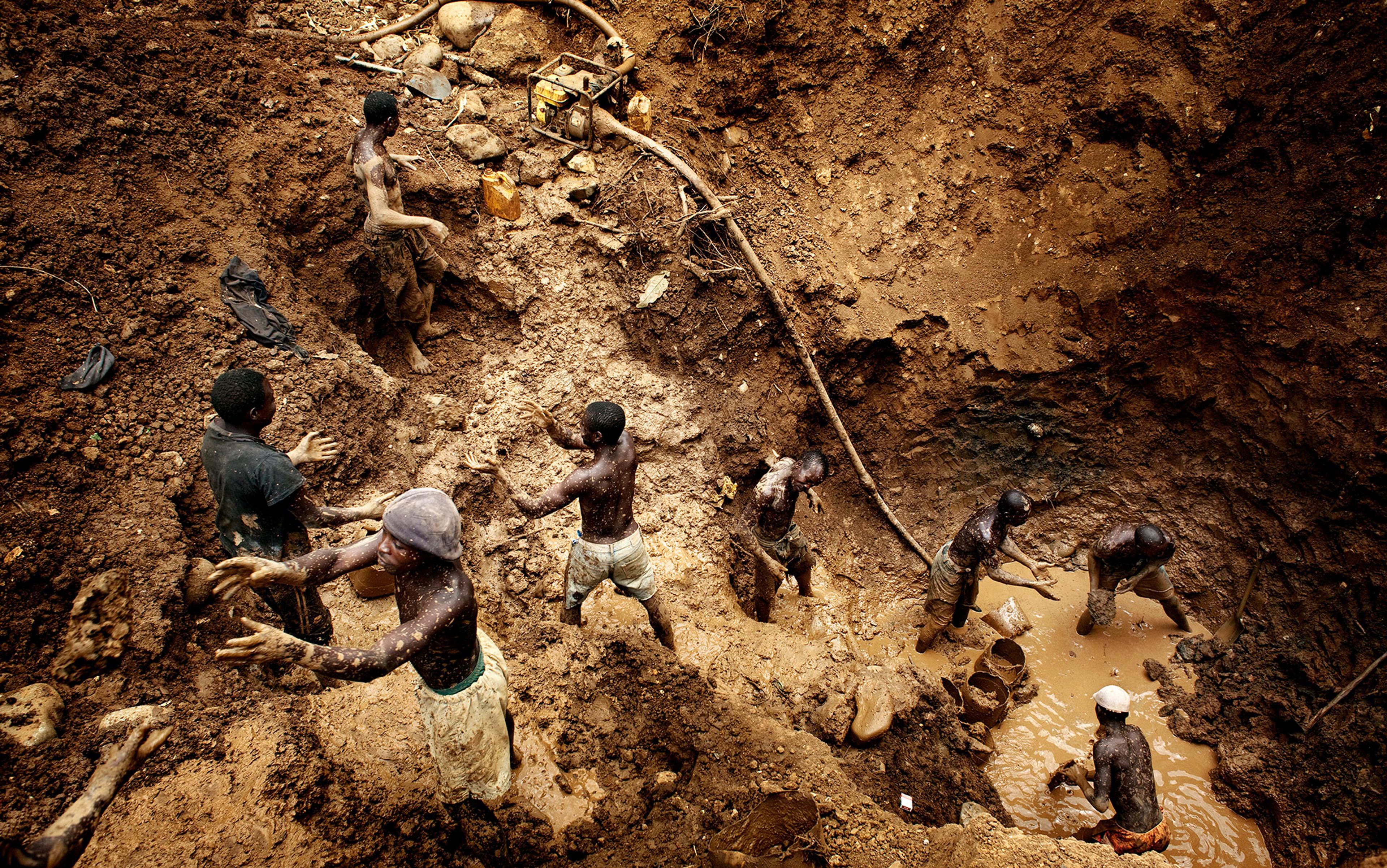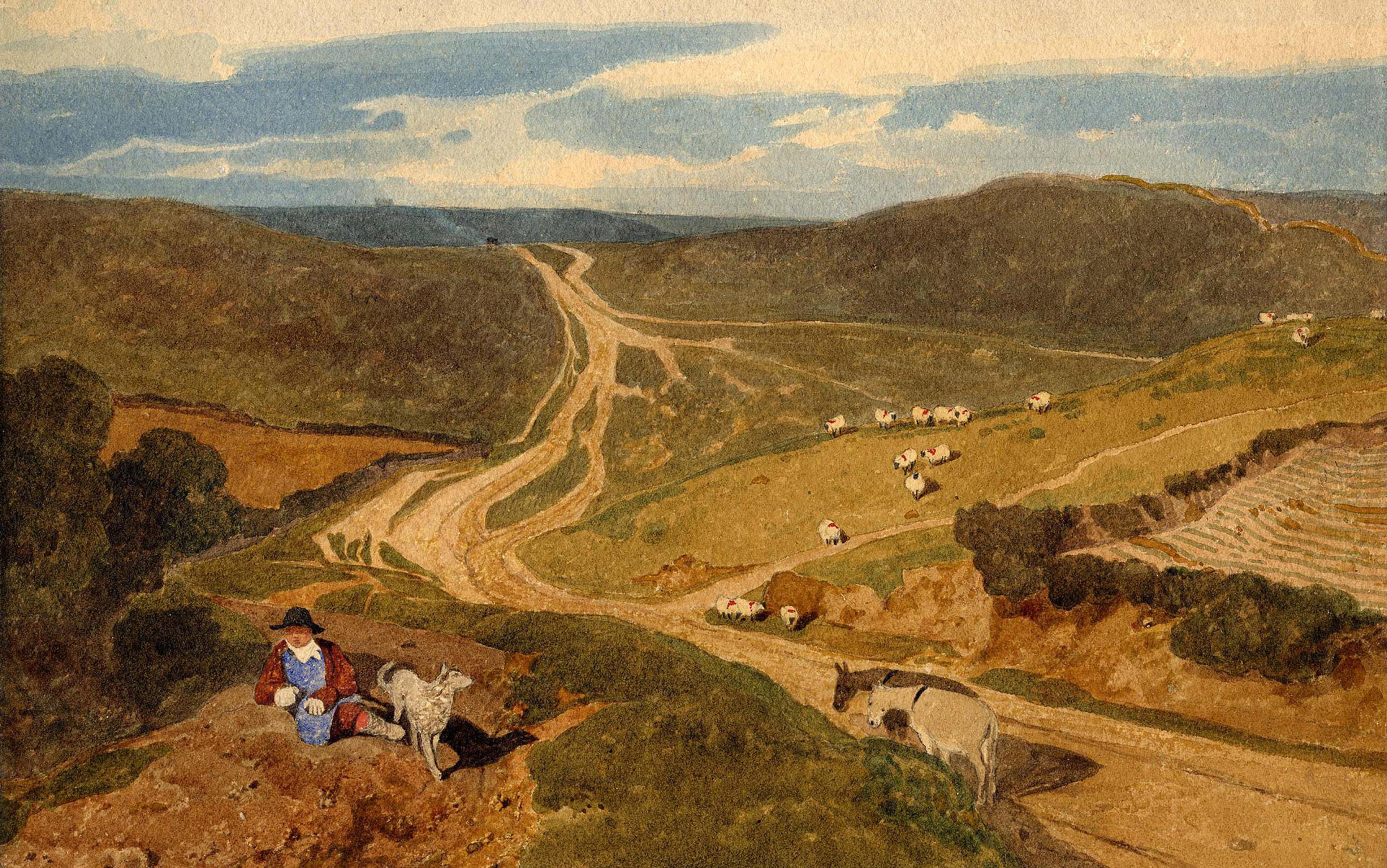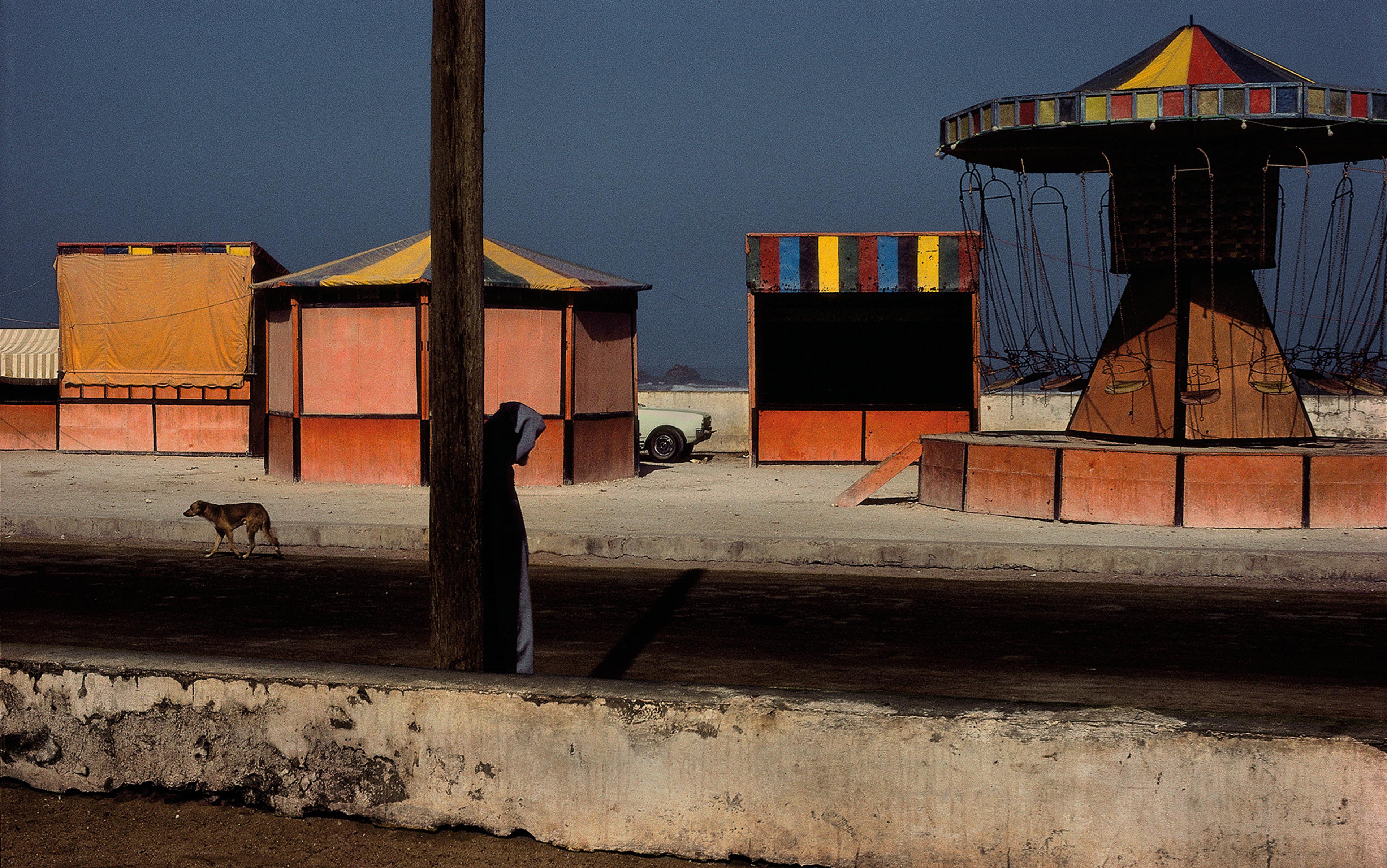It’s 38 degrees Celsius, even in the shaded alleys of Dubai’s gold souk. Bangles and chains adorn every window, small bars and coins are stacked neatly in glass display cases, and the air is filled with the rhythmic clicks of luggage-wheels pulled briskly over tile.
I’m suffering through the heat on the trail of a metaphor, searching for a link in the global gold supply chain. Like the colourful powders piled high in the nearby spice souk, this gold has come from far away, much of it in small suitcases like those being wheeled all around me. Some of it has a troubled past, having travelled from parts of the world plagued by conflict and criminality. The relationship between minerals and violence isn’t immediately obvious, until you consider that conflict is necessarily a financial undertaking. Even when the source of hostilities runs deeper, money is needed to feed, arm and secure the continued loyalty of combatants. Some months after my trip to the souk, I would find myself sitting on the shaded balcony of a rundown hotel in Kampala, Uganda, drinking lemonade with a despondent and self-declared ‘general’ whose rebellion had stalled. His men, he explained, had been left with just a handful of bullets and no money to resupply.
After years of documenting human rights abuses, I had graduated to trying to understand and disrupt the economic forces that sustain cycles of violence – first for a non-governmental organisation and as a journalist, then later on behalf of the United Nations (UN). In parts of South Sudan, Afghanistan, the Democratic Republic of Congo, Colombia, the Central African Republic and elsewhere, I saw how natural resources are mined and illegally taxed by armed groups, criminal gangs and corrupt officials in ways that prolong and intensify violence and instability.
My work revealed not only the violence and danger still tied to the production of many of the resources we rely on – from gold and other minerals, to opium and timber – but also the tacit complicity of a wider set of actors, from traders and manufacturers to bankers and accountants. Like others working to protect labour standards, reduce conflict or protect the environment, I was therefore increasingly focused on mapping the journey these resources take on their way to international markets, in the hope of putting pressure on companies and regulators to take action.
This journey is almost invariably described as a ‘supply chain’ – a metaphor that’s become so successful that we often forget it’s there. It invites us to imagine a string of companies, each linked seamlessly to the next, passing materials along as they’re extracted, processed and assembled on their way into our lives.
A business consultant named Keith Oliver is credited with popularising the term in the early 1980s, although some earlier instances can be found. Oliver initially preferred the phrase ‘integrated inventory management’ and the abbreviation ‘I2M’, he says in an article in 2003. But when he pitched I2M to his clients, he noticed how their ‘eyes glazed over’ until he hit upon the more vivid image of a ‘chain of supply’ or ‘supply chain’.
There is, of course, no actual chain linking companies together, but since then the image of a supply chain has shaped the way we picture our global economy and how products move through it. It’s become so entrenched in our thinking that we find it hard to describe the process in any other way. But when we lose sight of the role that these images play in our thoughts, our ideas and imaginations are left constrained, shaped by a metaphor we’ve forgotten is there.
The success of the supply chain metaphor is now holding us back, limiting our capacity to solve the problems plaguing the global economic system. Like all good metaphors it has pared back complexity in order to expose something fundamental, but in this case, that complexity is us. As products and their journeys have taken centre-stage, we – the people who use and make them – are recast as mere stagehands, guided by economic forces that are ultimately beyond our control.
A few months ago, a former colleague sent me a photo she had received while documenting abuses in the mining industry. Three men are lying side by side on a grassy slope. All three are dead and, beneath the drizzling rain, a small crowd has gathered.
In Kalehe, in eastern Congo, where the photograph was taken, villagers make a living by mining cassiterite, an ore from which tin is derived, and other minerals. But the steep hills and heavy rains frequently result in deadly mudslides against which they have little protection. Such deaths are common in mining communities around the world. Workers in other industries face equally grave perils, from deadly fires in crammed textile factories, to modern slavery in agriculture. Here the supply chain metaphor does more than just explanatory work – it also shapes our moral response to such tragedies.
The philosopher Peter Singer’s essay about preventable human suffering, ‘Famine, Affluence, and Morality’ (1972), has been influential in this regard. While it’s common to treat the suffering of those far away from us as less important or urgent, he argued, this is a moral failing on our part. Mere physical distance doesn’t limit our duty to help those in need. The image of a supply chain appears to have helped to close some of this moral distance by drawing a direct line between us – an implied consumer – and a geographically distant but connected series of companies.
The mental picture of a supply chain might help us describe these problems but doesn’t help solve them
The supply chain is now a well-established way to try to hold companies to account for the behaviour of at least some of the subcontractors, traders and suppliers that they rely on. In an address in 2017, John Ruggie – the architect of the landmark UN Guiding Principles on Business and Human Rights (2011) – identified ‘the challenge of securing socially sustainable supply chains’ as one of the highest priorities, estimating that these affect the lives of about 1 billion people. Supply chains have become central to the work of the Organisation for Economic Co-operation and Development and the International Labour Organization. Even laws, such as the Modern Slavery Act (2015) in the United Kingdom and the European Union’s Conflict Minerals Regulation (in force from January 2021), now explicitly require some companies to scrutinise their supply chains for risks and abuses.
Translating greater awareness into tangible progress, however, has proved difficult. Despite decades of campaigning, government initiatives and industry promises, problems such as child labour, conflict diamonds and sweatshops are still uncovered with alarming regularity. During this time, the face of many industries has changed almost beyond recognition, thanks to innovations spanning automated robotic production lines to next-day delivery at the click of a button. Similar innovation has, however, been slow to transform the social and environmental footprints of these same industries. At the same time, a dizzying array of standards and certificates designed to simplify our choices as consumers have only added to the confusion. The more information we seek, the less clear it is how we can act responsibly – inevitably leading many to abandon the enquiry altogether. The mental picture of a supply chain might help us describe these problems, but it doesn’t necessarily help us solve them.
Metaphors that we no longer recognise as images are sometimes called ‘dead metaphors’, killed by their own success and overuse. Yet dead metaphors aren’t as inert as the phrase implies. Sometimes, the images that we’ve forgotten about are the ones that act most powerfully upon us – though quite how they do so remains something of a mystery.
Aristotle, moved by the talents of ancient orators, believed that the effective use of metaphor was a form of genius. But modern linguists and philosophers remain divided on how a good metaphor succeeds in communicating so much beyond the literal meaning of its words. William Shakespeare’s Juliet is, of course, not the Sun. Yet the phrase tells us so much more about the depth of Romeo’s love and the centrality of Juliet to his life than a false statement about astronomy.
It’s tempting, perhaps, to go looking for this richer figurative meaning of a good metaphor somewhere other than in the literal meaning of its words. If this information is successfully conveyed by the phrase, its literal meaning must, at some point, undergo some transformation. Perhaps the context in which it is spoken, or some set of linguistic rules we have all subconsciously internalised, gives the phrase more significance than that usually assigned to the word ‘Sun’. This is the interpretation of metaphor favoured by theorists such as Max Black or Harold Skulsky.
Metaphors, far from mere linguistic adornments, are central to our ability to navigate the world around us
Other thinkers have challenged efforts to locate a metaphor’s actual meaning hidden somewhere within the words and sentences of which it is made up. Such a search, argues the philosopher Donald Davidson, is as misguided as one that goes looking for a specific meaning somewhere in a photograph or picture. Like the impact of a powerful photograph, what we confuse for the meaning of a metaphor is instead an effect, produced in the reader or listener by clever use of ordinary language. A metaphor, like a joke, is a small piece of verbal performance art designed to provoke a response in its audience.
Certain cognitive linguists have rejected such attempts to reduce metaphor to a kind of skill or piece of linguistic trickery, which we could, in principle, live without. In their influential book Metaphors We Live By (1980), the cognitive linguists and philosophers George Lakoff and Mark Johnson argue that metaphors, far from mere linguistic adornments, are in fact central to our basic ability to understand and navigate the world around us by using concepts to categorise and make sense of what we experience. This conceptual system, they argue, is fundamentally metaphorical. Across cultures and language, simple and familiar patterns of thinking are used to unpack and process more complex phenomena. Love is like a journey, replete with ‘fellow travellers’, ‘bumps in the road’ and relationships that end up ‘going nowhere’. Arguments are like war, with ‘indefensible positions’, ‘shot down’ to reveal both ‘winners and losers’.
While each of these accounts might disagree about how the feat is accomplished, they’re united in recognising the power of metaphor to shape and influence our thoughts. Their divergence originates in the shared observation that a well-chosen metaphor can lead our minds in one direction and away from another with surprising ease. They disagree as to why.
‘It was doubtless an ingenious idea to call a camel the ship of the desert, but it would hardly lead one far in training that useful beast,’ noted the novelist George Eliot in The Mill on the Floss (1860) – a wry aside about the dangers of over-reliance on metaphor. But we’ve failed to heed Eliot’s advice about the limits of metaphor when it comes to how the idea of the supply chain constrains our thinking about the global economy.
First, the image of a ‘chain’ almost inevitably invites us to frame problems as ‘weak links’. That’s effectively what I was looking for in the gold souk in Dubai. As the sun set and the heat faded, a trail of naked bulbs and a concrete staircase led me to a cramped fourth-floor office, where gold from eastern Congo is bought and sold. The next day, I watched young men stack crude gold bars on a scale that had likely weighed gold from the mines of Darfur not long before.
These are the physical entry points by which gold linked to violence and abuses can enter global markets, before travelling onwards to bank vaults and jewellers. The work that goes into uncovering these links is critical, as are efforts to hold these companies and individuals to account.
But the fact that these links exist doesn’t prove that they’re the only or even the main problem. In fact, the predictable regularity with which researchers such as me can find them suggests they’re a symptom rather than a cause. Yet our mental picture of a strong supply chain makes it difficult to imagine progress as anything other than replacing a few bad links with stronger ones. That steers us away from a deeper reflection on the systemic pressures and incentives that created the problems in the first place – not least the pressures to increase profits through larger production volumes at ever-lower prices. These pressures regularly combine with wider problems, such as weak labour protections, poor environmental regulation and outsized corporate influence, to pass on the resulting hardships to those least able to resist them, such as miners and textile workers.
The notion of weak links in a supply chain also discourages us from questioning the value of an increasingly fragmented extraction and production model – an ever-longer chain. Such chains have continued to grow out of a patchwork of regulations that effectively encourage large companies to distance themselves from the realities of their production. They do this by outsourcing less-savoury components to a growing number of subcontractors and consultants, who they can then claim neither work for nor represent their company. The more complex the production model becomes, the more reasonable it appears to question the limits of a company’s responsibility to police anyone beyond its direct suppliers. In this way, companies have been allowed to manufacture a kind of deniability and pass responsibility for problems down the chain – fixing weak links that are found, but leaving the broader business model unchanged.
A vast compliance industry has grown up over the past decade, focused first and foremost on helping companies show that their supply chains are clean. It has helped to devise new means of identifying weak links, and to explain (away) why they couldn’t possibly have been detected any earlier. Countless labels and certificates have been designed to communicate these efforts to consumers, which in turn discourage them from asking further questions. Far less energy has been devoted to reflecting on a business model that produces faulty chains with such alarming regularity, or to solving the problem rather than managing the reputational and legal risks. Reimagining the relationship between consumers, companies and products as something other than interlocking but ultimately discrete links might be necessary to redress this trend.
Enlisting consumers as the moral compass for problems bound up with consumerism is problematic at best
The second way in which the supply chain metaphor limits our thinking is by focusing our attention on products, not people. We talk of supply chains for T-shirts, gold rings and mobile phones. People are secondary and are identified only in terms of the roles they play in production, as miners, garment workers or jewellers. In more affluent parts of the world, this line of thinking inevitably leads most people to be cast as consumers, supposedly playing their role as only the final link in the chain.
Once cast as ‘just’ consumers, however, our moral agency is quickly reduced to fit this role. We are led to view our consumption choices as the primary outlet for our values and responsibilities, overlooking the possibilities and responsibilities that attach to other roles we play as employees, shareholders and citizens who ultimately benefit from many of these problems. It also implicitly identifies those with the means to consume as the primary voices when assessing the prevailing economic order, often at the expense of those who suffer its consequences more directly.
This natural extension of the supply chain metaphor is most clearly reflected in countless calls that urge consumers to use their purchasing power to reshape the world. Through decisions about what to buy and where to buy it, we are, in effect, encouraged to signal our preferences and vote for our preferred corporate behaviours.
Being an informed and mindful consumer is important. But enlisting consumers as the primary tool and moral compass for problems bound up with consumerism is problematic at best. Most consumers have to balance moral considerations against other factors, such as time, cost and availability of alternatives. Moreover, most products bring together multiple supply chains, such as the product itself and its packaging. Focusing primarily on consumers also steers campaigns towards consumer goods and away from other products – such as gold bars, jet engines or World Cup stadiums – that often have a greater impact on the use of resources and corporate behaviour.
In this way, the supply chain metaphor encourages us to see yet more consumption as the principal means of addressing problems that are ultimately rooted in consumption. The more our agency is reduced to that of a consumer, the more important consumption becomes to the influence we have on the world. Buying even more stuff becomes a moral act, an expression of values akin to the civic duty of voting. Questioning this cycle of consumption, or retreating from it, comes to look like an abrogation of that responsibility.
This is perhaps most clearly visible when companies create additional premium lines for customers willing and able to signal their preferences for more responsibly produced products – subtly shifting the responsibility on to the consumer to choose cleaner supply chains, and away from the companies and governments with the power to ensure that no such choice is necessary.
There’s no question that the supply chain metaphor succeeds in closing some of the moral distance that troubled Singer, drawing a connection between the users and makers of a product. Consumers are hopefully moved, at least in part, by the thought that they owe something to those whose hands shaped and touched an object on its way to them. But the metaphor also makes it difficult to look beyond the roles and terms it imposes, and to ask tougher and deeper questions. Ethical consumption might be one way of nudging the global economic system in the right direction, but consumers can’t be expected to shop us to economic and environmental justice.
Where the supply chain metaphor has constrained us, the path to more thoroughgoing reform must start from an imaginative effort to reframe the complex economic relationships in which we all exist. The 2nd-century Stoic philosopher Hierocles might be something of a guide, with his belief that the self is shaped, at least in part, by our relationship to others.
Hierocles suggests that our relationship to others is patterned on a series of concentric circles. Like a succession of Russian nesting dolls, each circle sits inside one that is slightly larger. We occupy the innermost circle ourselves, followed by progressively larger circles representing our immediate family, community, country and eventually all of humanity. Our challenge, urges Hierocles, is to draw all these circles closer together and towards the centre, treating those in outer circles more and more like those nearer to us. A failure to do so isn’t an act of self-protection but, on the contrary, succeeds only in distancing us from a part of who we are.
Echoes of Hierocles’ message are clear in a more elaborate metaphor that’s central to the moral philosophy of Immanuel Kant. Kant invites us to picture ourselves as co-legislators in a kingdom where we’re all equally important and no one is treated merely as a means to the satisfaction of others. In such an ideal setting, he argues, the laws that we all agree to are the ones that would be truly just, and should also guide us in the real one.
These images both lead to simple and familiar question. Are we treating others in a way that we ourselves would want to be treated? Neither image precludes work in the service of others. In Kant’s imagined kingdom, miners and garment workers could still exist, producing materials ultimately destined for others. If this system is arranged in a way that’s truly just and fair, however, it must be based on laws that are acceptable to all its participants. This abstract ideal might be difficult to achieve in practice, but it supplies the true moral yardstick against which we should measure our own systems.
Stronger supply chains will get us only so far. The thing we’re trying to perfect is only an image
Perhaps the most famous Anglo-American rephrasing of the Kantian question belongs to the philosopher John Rawls. While he didn’t consider it directly, his basic test of justice would, in effect, ask us whether we would accept current modes of extraction and production, and the jobs that come with them, if we didn’t know which role we would play in this system ourselves.
It’s an indictment of the current system of extraction and production that the answer to this question is so obvious that even asking it seems radical. The terms that shape the lives of the billion or so people that Ruggie identified would, simply put, be unthinkable to many of us. The obviousness of the answer is also an indictment of how narrowly we have drawn the problem and constrained our imagination in our efforts to solve it.
Powerful as it is, the supply chain metaphor draws our attention away from the larger forces that shape the problems we should be tackling. These include the sustainability of current consumption patterns; the absence of economic alternatives; weak regulatory oversight; scant protection for whistleblowers and journalists; the ease with which corporate ownership can be hidden and disguised; and the commercial pressures and incentives that likely drive those profiting from abuses or taking shortcuts. Our efforts to build stronger and more resilient supply chains will get us only so far. The thing we’re trying to perfect is only an image, and a partial one at that. Alternative visions can help us return these broader issues to the debate, while reminding us, for example, of the importance of engaging everyone affected by global supply chains in the discussion of how they should be organised.
Such limitations are inevitable with any metaphor. Eliot went on to lament that: ‘we can so seldom declare what a thing is, except by saying it is something else’. The danger, then, isn’t in the use of metaphor itself, but in forgetting that this is what we’re using. The solution, therefore, can’t be just a search for a better metaphor – but rather to remind ourselves that we’re using one, and to draw on many more when trying to capture something that might be beyond simple words.






